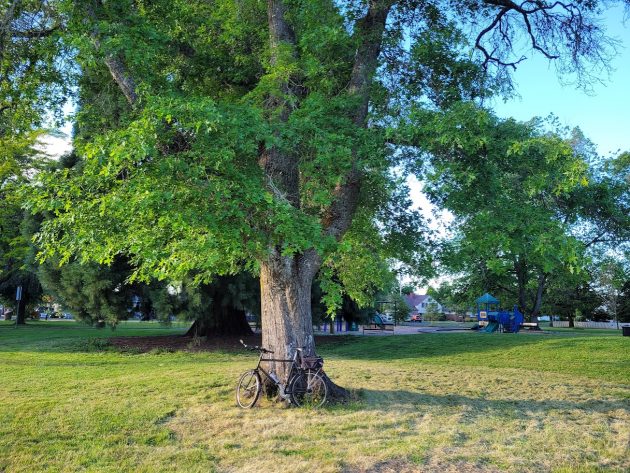
On Thursday evening, the bike leans against the Talena Park red oak said to be afflicted with root rot.
Two months ago a big red oak in Albany’s Takena Park was surrounded by caution tape and in danger of being cut down because of root rot. Now the tape is gone and the tree has been spared, at least for a while.
Jay Sharpe, the city forester in the Albany Parks and Recreation Department, flagged the tree as a potential danger in March after another oak nearby collapsed on to the sidewalk alongside Lawnridge Street.
The fallen tree had failed because of root rot, and Sharpe determined its neighbor had the same problem. But he held off on having it cut down pending further evaluation.
After passing the park on the bike and seeing the caution tape and barricades gone on Thursday, I asked Sharpe for an update. He sent this email:
“The tree was recently visited by contractors from the power company and pruned away from the power lines. This is good news because some weight was removed on the problem side of the tree. Seeing as the tree’s primary target is power lines, it makes me feel a little better that utility foresters and arborists looked at the tree as well.”
So what now?
“I would still like to have an advanced assessment of the tree performed, and we’re working with a tree care company to do that. It’s possible for oak trees to live a long time with this kind of disease. I’d like to see what we can do to facilitate that once we have a better idea of what’s happening inside the tree.”
This careful approach is in keeping with Albany’s interest in preserving the city’s tree canopy whenever possible.
In the same vein, the parks department this month asked the city council to tighten regulations aimed at preserving mature trees on private property, and the council did so.
On May 22, the council voted 5-0 (with Councilor Ramycia McGhee absent) to require permits for the “removal” of trees with a circumference of 5¼ feet or more, measured 4½ feet above the ground. The previous permit requirement applied only to trees with a circumference of 6½ feet or more.
The change in the municipal code also expands the definition of “removal.” It used to mean cutting a tree down. Henceforth, it also means damaging a tree or its roots so it will decline or die. (hh)

As an owner of 6 oak trees with the largest having a circumference of 250″ and 2 of them have fallen in the last 2 years, 1 of which had total root rot, I would not leave them as they are a total hazard. The last one to fail toppled with no wind or anything to cause it so I will be pruning them back to virtually no canopy because they are along a road and my barn and could do serious damage with no warning.
Also, tree grow fast here so just a matter of planting new trees. It is better to take down trees for safety reasons.
The regulations really don’t mean anything. People are still allowed to cut down sequias and other large trees for basicly no reason. Our neighbor was allowed to take out two healthy 75 ft redwoods larger than 6.5 ft in diameter simply because he didn’t like them.
I don’t know about this red oak ( Quercus rubra) , a red oak does normally does well in the WV. It could be compaction ,standing in a low spot or soil conditions that effects its environment to thrive or suffer. As for the cities policy about large trees it is more nuanced. On public parks it’s everybody’s trees, people would chain themselves to trees in order to protect the tree from being removed, it’s emotional for people. On private property it’s not just about your tree, people come on go but the tree is part of the neighborhood. People often do not know the type of tree that they have, it’s value besides it’s losing its leaves or provide shade. The problem often is people plant the wrong trees to close to their home and don’t realize that it will grow to its maturity over time. Look at all the sidewalks in town that are affected by tree roots, could have easily been avoided by proper planning, by the type of tree or designed space for it. As for the trees underneath power lines, people don’t not realize that trees grow to its maturity . The problem I have is with the power line contractors these guys are no arborist, they just cut anything in their way. This year’s crew is really bad, instead of cutting branches close to the wires they will cut one whole side off a tree, which will make the structure of a tree to be unbalanced, becoming a safety issue.